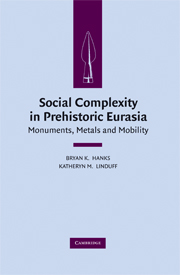Book contents
- Frontmatter
- Contents
- Contributors
- Foreword: From Myth to Method: Advances in the Archaeology of the Eurasian Steppe
- CHAPTER 1 Introduction: Reconsidering Steppe Social Complexity within World Prehistory
- PART ONE FRAMING COMPLEXITY
- PART TWO MINING, METALLURGY, AND TRADE
- CHAPTER 7 Introduction
- CHAPTER 8 Formation of the Eurasian Steppe Belt Cultures: Viewed through the Lens of Archaeometallurgy and Radiocarbon Dating
- CHAPTER 9 Late Prehistoric Mining, Metallurgy, and Social Organization in North Central Eurasia
- CHAPTER 10 The Bronze-Using Cultures in the Northern Frontier of Ancient China and the Metallurgies of Ancient Dian Area in Yunnan Province
- CHAPTER 11 Production and Social Complexity: Bronze Age Metalworking in the Middle Volga
- CHAPTER 12 Early Metallurgy and Socio-Cultural Complexity: Archaeological Discoveries in Northwest China
- PART THREE FRONTIERS AND BORDER DYNAMICS
- PART FOUR SOCIAL POWER, MONUMENTALITY, AND MOBILITY
- Index
CHAPTER 9 - Late Prehistoric Mining, Metallurgy, and Social Organization in North Central Eurasia
from PART TWO - MINING, METALLURGY, AND TRADE
Published online by Cambridge University Press: 26 January 2010
- Frontmatter
- Contents
- Contributors
- Foreword: From Myth to Method: Advances in the Archaeology of the Eurasian Steppe
- CHAPTER 1 Introduction: Reconsidering Steppe Social Complexity within World Prehistory
- PART ONE FRAMING COMPLEXITY
- PART TWO MINING, METALLURGY, AND TRADE
- CHAPTER 7 Introduction
- CHAPTER 8 Formation of the Eurasian Steppe Belt Cultures: Viewed through the Lens of Archaeometallurgy and Radiocarbon Dating
- CHAPTER 9 Late Prehistoric Mining, Metallurgy, and Social Organization in North Central Eurasia
- CHAPTER 10 The Bronze-Using Cultures in the Northern Frontier of Ancient China and the Metallurgies of Ancient Dian Area in Yunnan Province
- CHAPTER 11 Production and Social Complexity: Bronze Age Metalworking in the Middle Volga
- CHAPTER 12 Early Metallurgy and Socio-Cultural Complexity: Archaeological Discoveries in Northwest China
- PART THREE FRONTIERS AND BORDER DYNAMICS
- PART FOUR SOCIAL POWER, MONUMENTALITY, AND MOBILITY
- Index
Summary
In recent years, one of the most vibrantly debated prehistoric developments in the Eurasian steppe region has been the emergence of the Sintashta culture, which is dated from 2100 to 1800 cal. bce (G. B. Zdanovich 1988, 1989). The contributions in this volume by Anthony and Frachetti stress the importance of the Sintashta case study, and Anthony, in particular, argues for a strong connection between changing environmental conditions, an increase in the scale of warfare and chiefly competition, and the emergence of a broader economic pattern of exchange between Central Asia and the Sintashta settlements in the southern Urals zone.
This chapter investigates in more detail the relationship of Sintashta social organization to mining and metals production in that region. Many uncertainties still surround the scale and nature of bronze production connected with the emergence, development, and decline of the Sintashta archaeological pattern. These important issues are part of a much broader problem that exists within contemporary studies of the steppe region concerning the relationship between metal- producing communities, local micro-regions, and larger supra-local systems of trade and exchange. Traditional views of Eurasian metallurgy have often highlighted the development and diffusion of metal technology and objects within larger regional networks. In contrast, this chapter emphasizes the need to better understand the micro-regional impact of metallurgical production and its effect on the development of specific forms of social organization and complexity. From this perspective, it is argued that the Sintashta pattern still remains enigmatic in terms of the actual characteristics of its social complexity and the economic system connected with its development.
- Type
- Chapter
- Information
- Social Complexity in Prehistoric EurasiaMonuments, Metals and Mobility, pp. 146 - 167Publisher: Cambridge University PressPrint publication year: 2009
- 11
- Cited by

